Explore the moves in this workout:
Bonus: Full-Body Workout
When you’re focused on building strength, it’s easy to get lost in the onslaught of complicated, sometimes-conflicting fitness advice, workout trends, and gym hacks that rise to popularity on social media. But just because a routine is trending doesn’t make it scientifically sound or effective.
Rather, the programs that offer the best, most sustainable results prioritize balance and progressive overload. One such time-tested approach is push-pull training: The combination of push and pull exercises ensures you hit your major muscle groups to build balanced strength.
“A push-pull workout is essentially a well-organized full-body routine,” explains Life Time master trainer Cliff Edberg, RD, CPT.
“A push-pull workout is essentially a well-organized full-body routine.”
Push exercises involve pushing a weight away from your body; they target the pecs, triceps, anterior deltoids, and quadriceps muscles. Think squats, pushups, and chest presses.
Pull exercises, on the other hand, call for pulling a weight toward your body. This motion can be seen in many exercises that target the posterior chain, or back-body, which includes the lats, spinal erectors, glutes, and hamstrings. Rows, pull-ups, and deadlifts are common examples.
While a combination of push and pull exercises is ideal, Edberg tends to see people gravitating more toward push exercises. And though pushing moves are great in their own right, prioritizing them exclusively can result in an imbalance.
Making matters worse, “the average person does a lot of sitting,” Edberg says, a pattern that stresses the shoulders and further weakens the hamstrings and glutes.
Over time, this combination of prolonged sitting and push-centric workouts can lead to strength imbalances, which Edberg says can cause shoulder, knee, and back pain.
Because pushes and pulls target different muscle groups, programming both into your workouts can help prevent such imbalances and make your whole body stronger and more resilient.
The Workout
Life Time master trainer Cliff Edberg designed the following full-body routine as a series of four push-pull supersets.
- For each superset, complete both exercises for the prescribed number of repetitions.
- Do two or three rounds, resting for 60 to 90 seconds at the end of each round, before moving on to the next superset.
Repeat this workout up to three times per week, or use the format as a template to build your own push-pull routines.
Superset 1: Lower Push + Upper Pull
1a) Lower Push = Dumbbell Suitcase Squat
This move activates most of the muscles in your lower body, including the glutes, quads, and hamstrings.
Perform 12 to 15 reps.
Full Instructions
- Stand with your feet hip-width apart and hold a dumbbell in each hand, arms hanging at your sides.
- Push your butt back and bend your knees to lower into a squat, stopping when your thighs are parallel or almost parallel to the floor.
- Pause briefly in the bottom position.
- Drive through your feet to push up as you rise to standing.
- Keep your torso upright and knees in line with your toes throughout the movement.
- To pregress the movement, omit the weights or shorten your range of motion when you lower into the squat.
1b) Upper Pull = Single-Arm Bench-Supported Dumbbell Row
Like other rowing exercises, this one targets the major muscles in your back, as well as the posterior delts (the muscles in the backs of your shoulders). But because this move is unilateral — meaning it uses one limb at a time — it will also challenge your core.
Perform 12 to 15 reps per side.
Full Instructions
- Start with your left knee — bent at a 90-degree angle — and left hand on a bench. Extend your right leg, planting your right foot flat on the floor.
- Hold a dumbbell with your right hand, right arm fully extended. (You’ll feel a slight stretch in the shoulder.)
- Keeping your neck and spine neutral, pull your elbow back toward your hip as you draw the dumbbell toward your rib cage. Stop when your tricep is parallel to the floor.
- Lower the dumbbell with control until your arm is fully extended and you feel a slight stretch in your shoulder.
⊕ Perform two or three rounds of superset #1, resting for 60 to 90 seconds at the end of each round.
⊗ Then move on to superset #2.
Superset 2: Lower Pull + Upper Push
2a) Lower Pull = Dumbbell Hip Thrust
As Edberg notes, this exercise is a safe and effective way to focus on the meaty muscle in your buttocks known as the gluteus maximus (or simply “glutes”). It also works the hamstring muscles in the backs of your thighs.
Perform 12 to 15 reps.
Full Instructions
- Sit on the floor and position your upper back against a flat bench.
- Lift your upper body onto the bench, such that the edge of the bench is resting firmly in your upper back.
- Place a dumbbell in the crease of your hips and bend your knees so your feet are flat on the floor. If this is uncomfortable, place a rolled-up yoga mat or blanket between your hips and the dumbbell. Hold the dumbbell in place and press your hips into the air until they are fully extended.
- Lower your hips and the dumbbell back down, keeping your upper back pressed against the bench throughout the movement.
- To pregress this movement, start with bodyweight hip thrusts before adding a dumbbell.
2b) Upper Push = Alternating Dumbbell Bench Press
This variation of the classic dumbbell bench press strengthens the chest, shoulders, and triceps. “The alternating motion helps activate the core and promote balance and stability,” Edberg says.
Perform 12 to 15 reps per arm.
Full Instructions
- Lie face-up on a bench with a dumbbell in each hand, positioned at chest height.
- Press the dumbbells straight up toward the ceiling.
- Keeping one dumbbell in a fixed position, lower the other with control until your elbow dips to just below the height of the bench. Keep your moving arm close to your body and your feet planted throughout the movement.
- Press the lowered dumbbell back up toward the ceiling and hold it in place while you lower the other.
⊕ Perform two or three rounds of superset #2, resting for 60 to 90 seconds at the end of each round.
⊗ Then move on to superset #3.
Superset 3: Lower Push + Upper Pull
The dumbbell step-up is a highly functional movement — as in, it’s useful for real-world situations — that builds balance and lower-body strength.
3a) Lower Push = Dumbbell Step Up
Perform 12 to 15 reps per side.
Full Instructions
- Hold a dumbbell in each hand and let your arms hang at your sides.
- Step your right foot onto a box or bench and straighten your right leg. Let the left leg float behind you or place it on the box or bench next to the right leg.
- Return to the starting position by bending your right knee and lowering your left foot to the floor with control, followed by your right foot.
- Repeat the movement, completing all reps on one side before switching.
- To pregress the movement, step onto a lower surface or omit the dumbbells.
3b) Upper Pull = Bent-Over Banded Lat Pulldown
This move is an effective way to work the lats (the large fan-shaped muscles in your back) in a vertical motion, especially if you don’t have access to pull-up bars or machines.
Perform 12 to 15 reps per side.
Full Instructions
- Anchor a resistance band to a sturdy object at about hip-height.
- Facing the anchor, grip a handle in each hand and step back until you feel moderate tension in the band while your arms are straight.
- Standing with feet narrower than hip-width apart, hinge forward at the hips to bring your torso parallel or almost parallel to the floor. Keep a soft bend in the knees.
- Pull the handles toward you until your elbows point behind you. Think of making a goal post with your arms.
- Extend your arms to return to the starting position. Keep your gaze on the ground throughout the movement.
⊕ Perform two or three rounds of superset #3, resting for 60 to 90 seconds at the end of each round.
⊗ Then move on to superset #4.
Superset 4: Lower Pull + Upper Push
4a) Lower Pull = Single-Leg Kickstand Romanian Deadlift
This single-leg exercise strengthens the hamstrings and glutes and improves hip mobility.
Perform 12 to 15 reps per leg.
Full Instructions
- Hold a dumbbell in your right hand, arm hanging at your side.
- Shift most of your weight onto your left leg and step the right foot back so you’re in a staggered stance and your right foot is propped up on your toes.
- Keeping your back flat and a slight bend in your left knee, hinge forward at the hips until you feel tension in your left hamstring.
- Return to the starting position.
- Repeat the movement, completing all reps on one side before switching.
4b) Upper Push = Alternating Dumbbell Shoulder Press
This vertical pressing exercise not only activates your shoulders and triceps, but it also mimics everyday movements like lifting bags and objects overhead. Plus, the alternating motion makes things a bit more interesting.
Perform 12 to 15 reps per arm.
Full Instructions
- Stand with your feet hip-width apart and hold a pair of dumbbells in front of your shoulders, palms facing in.
- Extending the arm, press one dumbbell straight up toward the ceiling. Pause, and then lower the weight back to shoulder-level.
- Repeat, this time pressing the opposite weight.
⊕ Perform two or three rounds, resting for 60 to 90 seconds at the end of each round.
Bonus: Full-Body Workout
Mix up your push-pull routine with this bonus full-body workout.
- Perform this workout in three supersets.
- Complete the movements in supersets 1 and 2 for the prescribed number of repetitions; perform the moves in superset 3 for 60 seconds each.
- For all the supersets, rest once you’ve finished both exercises.
Select weights you can lift with good form for the noted number of sets and reps. “Focus on form over speed by controlling the tempo,” advises strength and conditioning coach Jay Ashman, who designed this workout. For example, count to two as you lower the weight and repeat that same count as you raise the weight.
Do the routine up to three times per week; it will take approximately 45 minutes to complete.
Lower Body Superset
Push = Goblet Squat
This squat variation is gentle on the back while working the quads and glutes.
Perform 12 to 15 reps.
Full Instructions
- Holding a kettlebell or dumbbell at your chest, stand with feet hip width apart.
- Push your butt back and bend your knees to lower yourself into a squat. Keep your torso upright and knees in line with your toes throughout the movement.
- Drive through your heels to push up as you rise to standing.
Pull = Romanian Deadlift
Home in on your hamstrings and focus on proper hinge technique.
Perform 12 to 15 reps.
Full Instructions
- Stand with feet hip width apart and hold a dumbbell in each hand, arms hanging straight in front of your body.
- Push your butt back to hinge at the hips, allowing the weights to lower as you keep them close to your body.
- Lower the weights until you feel a stretch in your hamstrings and your hips no longer move backward. Squeeze your glutes as you return to the starting position.
⊕ Perform three or four rounds of the lower body superset; rest 45 to 60 seconds at the end of each round.
⊗ Then move on to the upper body superset that follows.
Upper Body Superset
Push = Dumbbell Bench Press
Target your chest, triceps, and shoulders with this classic upper-body strength builder.
Perform 12 to 15 reps.
Full Instructions
- Lie face-up on a bench with a dumbbell in each hand, positioned at chest height.
- Press the dumbbells straight up toward the ceiling.
- Lower the weights with control until your elbows dip just below the height of the bench. Keep your arms close to your body and your feet planted throughout the movement.
Pull = Dumbbell Bent-Over Row
Build upper-back strength and counteract the hours you spend slouching at your desk.
Perform 12 to 15 reps.
Full Instructions
- With a dumbbell in each hand, hinge at the hips so your chest is about 45 degrees from the floor.
- Draw your shoulder blades together and bend your elbows toward your hips to pull the dumbbells toward your rib cage.
- Lower the weights with control until your arms are straight.
⊕ Perform three or four rounds of the lower body superset; rest 45 to 60 seconds at the end of each round.
⊗ Then move on to the core and conditioning superset that follows.
Core and Conditioning Superset
Core = Wide Straight-Legged Sit-Ups
Build core strength across a full range of motion by straightening your legs.
Perform as many good-form reps as possible in 60 seconds.
Full Instructions
- Lie flat on your back with legs extended in a wide V; reach your arms toward the ceiling.
- Engage your core as you sit up tall, keeping your legs on the floor and extending your arms straight ahead.
- Lower slowly back down to the floor.
Conditioning = Dumbbell Thrusters
This move will get your heart pumping and work your upper and lower body.
Perform as many good-form reps as possible in 60 seconds.
Full Instructions
- Hold two dumbbells at shoulder height, then squat down as low as you comfortably can.
- Use the power of your hips and glutes to explode back to standing, pressing the dumbbells overhead in one fluid motion.
- Lower the weights and repeat for as many good-form reps as possible in 60 seconds.
⊕ Do three to five rounds of the core and conditioning superset; resting as needed between rounds.
This article originally appeared as “Push and PUll for Strength ” in the September/October 2023 issue of Experience Life.
Main Workout Photography by: Colin Simmons; Styling: Pam Brand; Model: Nehemiah Owusu
Bonus Workout Photography by: Chad Holder; Styling: Pam Brand; Model: Melissa Story
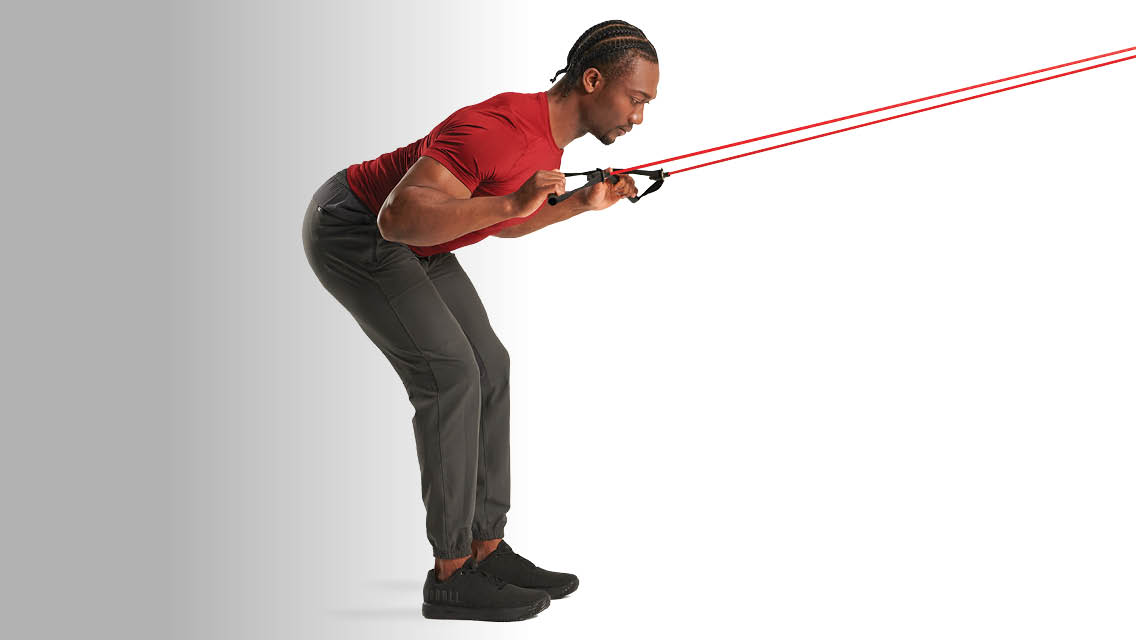

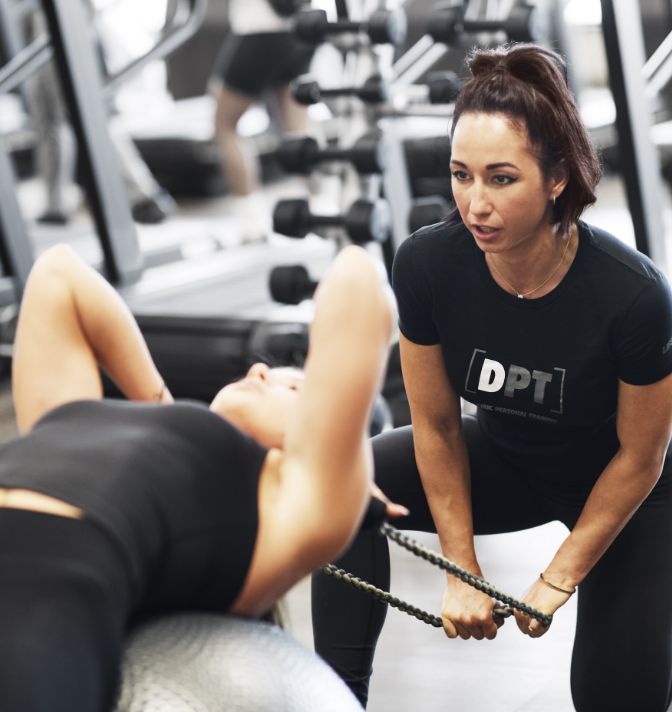
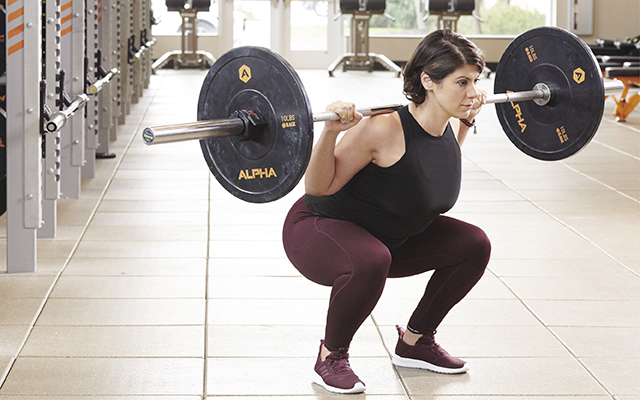
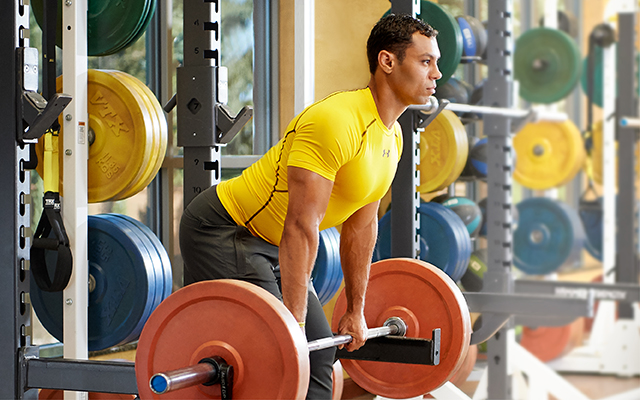
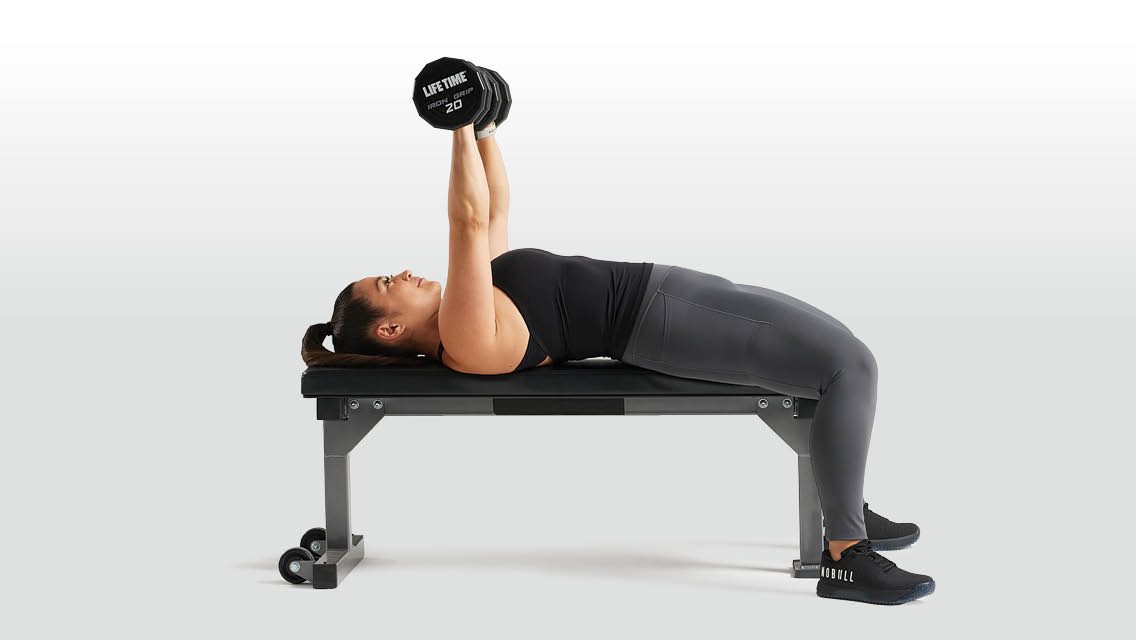
This Post Has 0 Comments